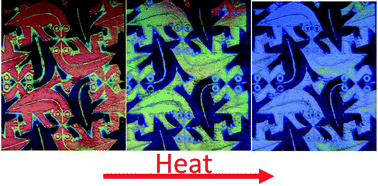Dynamic high contrast reflective coloration from responsive polymer/cholesteric liquid crystal architectures†
Abstract
We report on high

* Corresponding authors
a
Materials and Manufacturing Directorate, Air Force Research Laboratory, 3005 Hobson Way, OH, USA
E-mail:
timothy.bunning@wpafb.af.mil
Fax: +1 937-255-1128
Tel: +1 937-255-9649
b
Liquid Crystal Institute & Chemical Physics Interdisciplinary Program, Kent State University, Kent, OH, USA
E-mail:
dyang@kent.edu
Fax: +1 330-672-2796
Tel: +1 330-672-2565
We report on high

 Please wait while we load your content...
Something went wrong. Try again?
Please wait while we load your content...
Something went wrong. Try again?
M. E. McConney, T. J. White, V. P. Tondiglia, L. V. Natarajan, D. Yang and T. J. Bunning, Soft Matter, 2012, 8, 318 DOI: 10.1039/C1SM05980G
To request permission to reproduce material from this article, please go to the Copyright Clearance Center request page.
If you are an author contributing to an RSC publication, you do not need to request permission provided correct acknowledgement is given.
If you are the author of this article, you do not need to request permission to reproduce figures and diagrams provided correct acknowledgement is given. If you want to reproduce the whole article in a third-party publication (excluding your thesis/dissertation for which permission is not required) please go to the Copyright Clearance Center request page.
Read more about how to correctly acknowledge RSC content.
 Fetching data from CrossRef.
Fetching data from CrossRef.
This may take some time to load.
Loading related content
